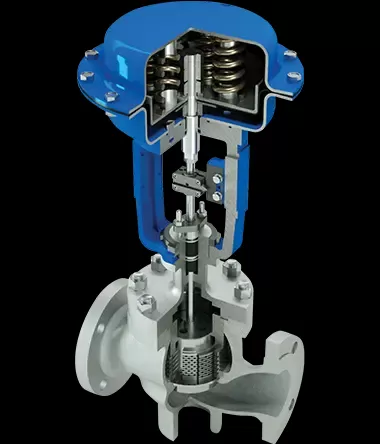Notifications

5 minutes, 32 seconds
-152 Views 0 Comments 0 Likes 0 Reviews

We are a leading control valve manufacturer in China, providing high-quality valves and control actuators designed to meet a wide range of industrial applications.
Pneumatic Globe Control Valves are vital components in many industrial systems, providing precise regulation of fluid flow, speed, and pressure. Equipped with pneumatic actuators, these valves respond to control signals by adjusting valve position to optimize fluid control. This article explores the fundamental working principles, components, selection criteria, and maintenance best practices for pneumatic globe control valves.
The globe valve body is the central housing where fluid flow is modulated. Typically designed as a two-port valve, the inlet and outlet ports are either positioned directly opposite each other or arranged at a 90° angle in angle globe valves. The valve body contains the internals: stem, disc (plug), and seat, which work together to regulate flow.
Globe valves are well-suited for demanding conditions such as high pressure, elevated temperature, and corrosive or viscous fluids. When installed on horizontal pipelines, standard globe valves may accumulate residual fluids, which can cause clogging or corrosion if left stagnant. Angle or oblique globe valves mitigate this by enabling proper drainage when not in use.
Common valve body materials include heat-resistant alloys such as cast iron, stainless steel, and carbon steel. These materials ensure durability and resistance to harsh operating environments common in chemical processing, oil and gas, and power generation industries.
Pneumatic actuators provide the mechanical force needed to modulate the valve position. Unlike rotary actuators commonly used for ball or butterfly valves, pneumatic actuators for globe valves operate using linear motion.
Two main types are used:
Piston Actuators: Compressed air moves a piston vertically, pushing the valve stem to adjust flow.
Diaphragm Actuators: Air pressure acting on a diaphragm causes vertical movement of the valve stem.
Both types offer precise and repeatable control of valve position, allowing accurate regulation of fluid flow, pressure, and temperature.
When a control signal from a process controller or supervisory system is received, the pneumatic actuator activates, moving the valve stem and plug to modulate fluid flow. Compressed air supplies the power, regulated via feedback control loops involving sensors or transmitters monitoring flow, pressure, or temperature.
This feedback allows continuous adjustments, maintaining the valve position at the setpoint to deliver precise control over the fluid system.
Choose materials based on fluid characteristics and operating conditions:
Stainless Steel: Preferred for corrosive or high-temperature applications due to superior resistance.
Cast Iron: Suitable for general applications where cost-efficiency and reliability are priorities.
Single-Acting: Uses spring return for emergency shut-off, closing rapidly when air supply is lost.
Double-Acting: Uses air pressure for both opening and closing, offering consistent operation for frequent cycling.
Flow rate and range
Operating pressure and temperature
Media compatibility
Ensure valve specifications align with these parameters to guarantee optimal performance.
Valve Centering: Proper alignment within the pipeline prevents leakage and uneven wear.
Flow Direction: Follow manufacturer markings to ensure correct fluid flow through the valve.
Cleaning: Remove debris or deposits from the valve seat and spool to avoid sticking or leakage.
Lubrication: Regularly lubricate actuator moving parts to minimize friction and extend service life.
Actuator Failure: Check air supply pressure and control signal wiring to ensure proper actuator function.
Valve Leakage: Inspect seals and seats for wear; replace as needed to restore tight shut-off.
Pneumatic Globe Control Valves combine durability, precision, and versatility, making them essential for regulating fluid flow, pressure, and temperature across diverse industrial applications. Understanding their components, operation, and selection criteria empowers engineers and technicians to optimize valve performance and reliability.
Proper installation and routine maintenance further extend valve lifespan, ensuring these critical components consistently contribute to efficient, safe, and stable system operation.Know more about Google SEO Directory

